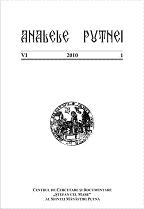Icoane ale maeştrilor ruşi din secolul al XV-lea la Mănăstirea Putna. Registrul apostolilor şi prăznicarele
Icons of the 15th Century Russian Masters at the Putna Monastery. The Register of the Apostles and the Icons of the Great Feasts
Author(s): Engelina SmirnovaSubject(s): History
Published by: Centrul de cercetare şi documentare ŞTEFAN CEL MARE
Keywords: guest masters; iconography; iconostasis; Moscow painting; Stephen the Great
Summary/Abstract: Eight icons from the Putna Monastery, each depicting an apostle, are all that is left from the register of an iconostasis of small proportions. The central icons of the register as well as those of Luke, Bartholomew, Jacob and Thomas were lost. The position and the silhouettes of the apostles as well as the draping of their vestments have direct correspondences in a series of iconostases painted by Moscow masters during the 15th century. The hand of the Moscow painters can be seen in the stylistic traits of the works: the character of the drawing and the pattern of the faces, the rhythmic organization of the ensemble and the peculiarities of the cold colouring. Nevertheless the icons were painted in Moldavia: the wood of the panels and the frame (profiled with double cavities and protuberances) are not characteristic for the Russian icons. This is also evident from the composition of the ensemble of icons: for the countries within the Byzantine realm the register with the apostles is typical, whereas for the Russian iconostases, with rare exceptions, the Deisis type of registers – registers, which comprise images of saints from various categories – are typical. The typology of the faces of the apostles is also different: the softly curved noses are not characteristic for the Russian iconography of the time. It is possible that the icons of the Great Feasts were part of the same iconostasis. They were painted on locally manufactured wood panels and the initial painting – preserved only on the icon of the Ascension – also belongs to a remarkable Moscow master. The icon masters that painted these icons from Putna belonged to one of the multiple branches of Moscow iconography from the last third of the 15th century, branches outside the influence of the famous iconographer Dionisy. Stephen the Great probably invited the painters in the period when the political and cultural relations with Moscow were developing actively, culminating with the 1483 marriage between Ivan Ivanovici – the eldest son of the great prince Ivan III of Moscow – and Helen, the daughter of Stephen the Great. The reason for inviting the painters could have been the decoration of the Dormition of the Mother of God church from Putna – built between 1466 and 1470 – or the renovation work at the same church after the 1484 fire. The peculiarities of this ensemble of icons shed a new light upon the character of the activity of the icon masters invited from one Orthodox country to another in the late Byzantine and post-Byzantine periods.
Journal: Analele Putnei
- Issue Year: 2010
- Issue No: 1
- Page Range: 7-32
- Page Count: 26
- Language: Romanian
- Content File-PDF

